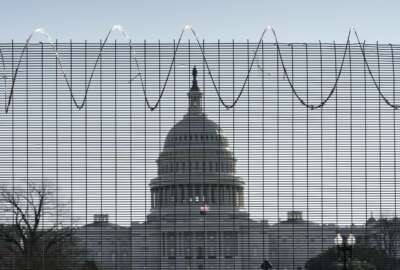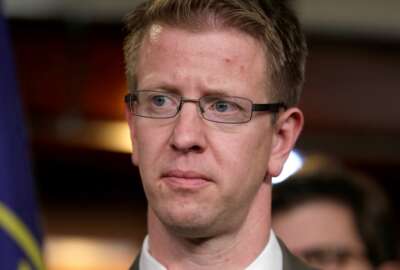
Despite outward appearances, Congressional staff doing more work than meets the eye
Pretty much everyone thinks Congress is only marginally functional. Among the underlying challenges are the conditions under which its tens of thousands of staff...
Best listening experience is on Chrome, Firefox or Safari. Subscribe to Federal Drive’s daily audio interviews on Apple Podcasts or PodcastOne.
Pretty much everyone thinks Congress is only marginally functional, except for maybe deficit spending. Among the underlying challenges for the first branch of government are the conditions under which its tens of thousands of staff members work. For some ideas for reforming the Congressional workplace, Senior Governance Studies fellow at Brookings Institution Molly Reynolds spoke to Federal Drive with Tom Temin.
Interview transcript:
Tom Temin: Ms. Reynolds, good to have you on.
Molly Reynolds: It’s good to be here, thanks for having me.
Tom Temin: And your report is quite lengthy and covers soup to nuts when it comes to the legislative branch. But as an employer, in many ways, it’s always been a step behind even the executive branch, much less the rest of industry in American life. So tell us generally, what does it look like?
Molly Reynolds: Yeah, so it’s really easy, I think, for lots of folks to forget that while Congress’s first job is to be a legislative branch to pass legislation, to do oversight, that it’s also a place where tens of thousands of people go to work every day. And I do think that this is an interesting time to be having this conversation. Because I do think that in the aftermath of the attack on the Capitol on January 6, we are actually talking more about some of these workplace issues. But when we kind of think broadly, I think we need to focus on things like making sure that congressional offices can recruit and retain top talent to make sure that Congress is a safe place to work. That, again, is I think, particularly important in the aftermath of January 6, but we’ve seen over the past year, a lot of COVID related concerns as well. Another thing that I think people forget sometimes about Congress as a workplace is that certainly for folks who work in individual member offices, or for committees, it’s actually quite decentralized on a lot of the kind of workplace decision making questions. There are some policies that are set centrally for the House and the Senate, but there’s a lot that’s left up particularly to individual members to decide who to hire, who to fire, how much to pay folks, some latitude over what kinds of benefits to offer that sort of thing. So I think there’s another place where we forget that it is really quite different as an institution than a lot of private sector employers.
Tom Temin: Yes. And within Washington, it’s all over the place as far away as, say the Government Publishing Office or the Congressional Budget Office, these are outside of the regular office buildings we normally think of when we think of Congress. And then from the other angle, it’s also a national workforce, because every member has multiple, in the case of the Senate, district offices.
Molly Reynolds: Even those of us who think a lot about congressional staff, I think sometimes overlook the needs and concerns of state and district staff. And those again, in the past several weeks, we’ve been confronted with questions about how to keep those folks safe in their offices, which don’t have the same physical security protections as the United States Capitol. And so there are lots of moving pieces here that we really need to pay attention to when we think about why it’s important to make sure that Congress has a healthy, productive workforce supporting its key mission for the country.
Tom Temin: And when people return to the offices in more numbers, you’ve documented that there is quite a bit of worry about whether they will, in fact, be safe, will they’ll be sanitized? And then there’s the issue of physical safety, as we’ve seen the breach that happened in January.
Molly Reynolds: Yeah. And anyone who has gone anywhere near the US Capitol in the past month or so will have seen kind of the current security posture. And there are a lot of important and hard questions about what that should look like going forward. And the perspectives of congressional staff I think are really important, and that we definitely shouldn’t overlook them. Over the past couple of days, the number of the folks responsible for security on Capitol Hill, both on January 6 and going forward, have been testifying. So it’s a real active conversation right now about how to ensure folks safety when they do return to the office in larger numbers.
Tom Temin: Yeah, I guess that’s kind of a centuries long phenomenon, or a century long phenomenon in Washington, DC, how much more secure it seems to get?
Molly Reynolds: Yeah. And it really gets back to this issue of how do we hold in our heads at the same time the fact that Congress has these legislative responsibilities, they’re doing the public good, we don’t want Congress to be, quote, run like a business because it has a different mission. It’s not trying to maximize profits or something. But it’s also a place where thousands of people go to work every day. And we need to make sure that we’re thinking about what those individuals need as employees all the way from the folks who work in the cafeterias and the folks who do the maintenance of the physical plant, up to the the legislative staff in members offices and on committees.
Tom Temin: And what about the diversity and inclusion issue? Is that an issue on Capitol Hill as it has become?
Molly Reynolds: It’s an enormous issue. So, again, this is a place where we’ve seen some really important stories come out in the aftermath of January 6 about the particular needs and challenges faced by staffers of color, but it’s not a new issue. There’s lots of data that folks have worked hard to put together that tells us that congressional staff don’t look like the country they serve. That Black Americans, Latino Americans, other Americans of color are underrepresented in the congressional staff ranks. And we need those folks to bring really important perspectives to the policymaking process. And we need them to feel like they’re safe and valued in the workplace. And so Congress has taken some steps to first try to get a handle on actually what does its workforce look like. And then try to take some additional steps to make sure that there are pipelines to bring in more diverse talent going forward. So things like paid internships, I think lots of folks listening who probably had their first break in Washington working in an unpaid internship, and that really skews who has access to those first rungs of the career ladder. And so thinking about things like that, as we try to, again, ensure that congressional staff look like the country that their elected representatives have sent to Washington to serve them.
Tom Temin: Are there a multiplicity of hiring mechanisms? That is to say, if you’re going to work for each individual member, that member hires you — if you’re going to work for CBO, or Library of Congress, for example, how does that work?
Molly Reynolds: Yeah, so there are a multiplicity of hiring mechanisms is a great way to put it. Individual member offices are responsible for hiring their own staff. Folks who go to work at one of the legislative support agencies, like the Government Accountability Office, the Congressional Budget Office, Congressional Research Service, those work through a little bit more by a centralized hiring process. And so what this leaves us is kind of the changes that we need to improve the system, both need to involve empowering those individual offices and equipping them with tools, but then also providing some centralized support. And this is where things like the relatively new House Office of Diversity Inclusion come in. So providing some support centrally to these individual offices who are still going I don’t think anyone is imagining that we would go to some sort of centralized hiring approach for member staff that wouldn’t work particularly well. But we do need to make sure that offices have the support and are equipped with the tools to do the work themselves.
Tom Temin: And also following some of the recommendations from the Select Committee on the Modernization of Congress, and I hope they’re paying attention to that hard working select subcommittee. But you mentioned streamlining of administrative operations. What’s that?
Molly Reynolds: This is another another piece where I think that folks who are not on Capitol Hill would be a little surprised to learn some of the administrative practices that Congress still uses. A huge area where this has been an issue with in terms of technology and adapting to new technologies. I think that one of the maybe silver linings of the past year is that Congress actually has been forced to accelerate some of its willingness to try various new technological approaches to things. We’ve all probably watched or seen clips of things going a little bit awry in some of Congress’s remote hearings. But nearly the fact that they have started to figure out how to do some of that, and how to keep the mechanism, the legislative branch working in this time of pandemic, I think it’s actually a promising sign. And so one thing I do think that we, you mentioned the select committee, one thing that I do hope that they take a look at over the coming Congress is kind of what lessons can we learn from COVID? And how can we be better prepared for a future situation that requires a dispersed workforce? But also what lessons might we want to keep going forward, again, particularly in terms of technology?
Tom Temin: Well, I guess somebody has to keep the publishers of pink pads of “while you were out” memos going, right?
Molly Reynolds: Yeah. So it’s certainly the case that when it is safe to do so, many of Congress’s operations will return to being in person. I don’t think, again, anyone that’s suggesting that we keep the fully remote environment for the US Congress. But like I said, I do think that there are some particularly again around things like bringing in witnesses who can’t necessarily travel to Washington DC to testify in a hearing. We’ve made great strides over the past year on learning how to have this folks appear remotely. That’s a place where I do think that the select committees and others can learn important lessons from the experience last year.
Tom Temin: Molly Reynolds is a senior fellow in governance studies at Brookings, thanks so much for joining me.
Molly Reynolds: Thanks for having me.
Copyright © 2025 Federal News Network. All rights reserved. This website is not intended for users located within the European Economic Area.
Tom Temin is host of the Federal Drive and has been providing insight on federal technology and management issues for more than 30 years.
Follow @tteminWFED





